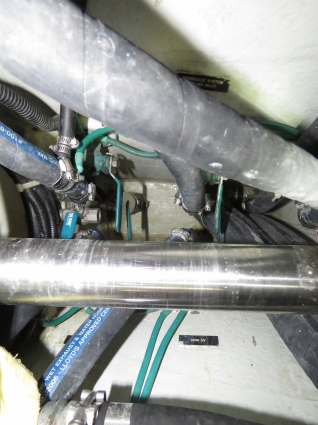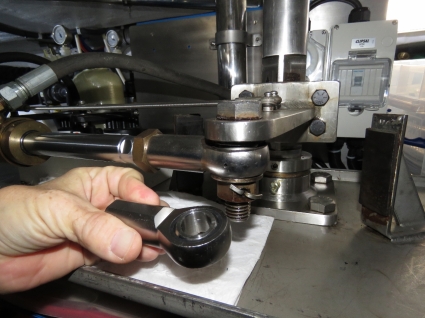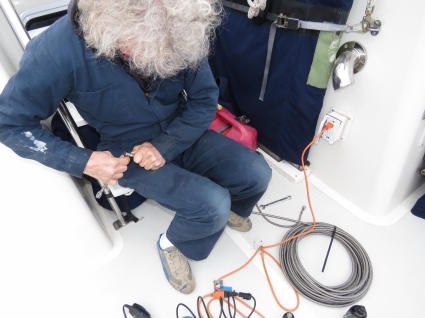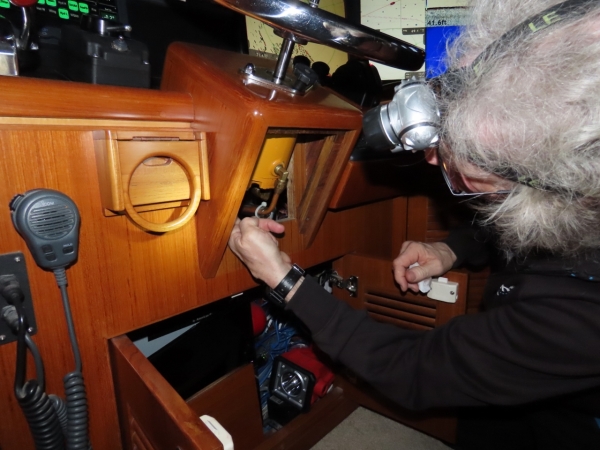We encourage all questions to be posted to the blog using the General Comments section on the site (Post Comment). But there are times when those involved don’t want all the details to be public. When these appear to be of general interest, we strip out those details in the public version of our answer in this new “Q&A” series of posts.
The first question relates to a steering oil leak during a crossing.
Question:
We were just over halfway into an overnight passage when our steering started to misbehave. We quickly checked our steering reservoir and found no pressure and a fluid level below the lower limit. We refilled and pressurized and steering resumed, but we knew we had a problem. Next, we checked our autopilot pumps and found that one of the copper tubing fixtures was leaking. At the time it was a rapid drip and we thought we could continue to refill and pressurize and complete the trip. Unfortunately, the leak worsened and we lost steering completely. The fluid was leaking as fast as it was replaced and we could not maintain pressure. With the autopilot pump off the leak slowed down but if the reservoir was pressurized, the rapid leak resumed. We could not steer with the wheel because we couldn’t pressurize the reservoir.
We hand-steered the boat 20 nm to a nearby anchorage. Fortunately we had intermittent cell service and were able to call a professional for advice. He suspected a crack in the copper tubing flare that fit inside the coupling. There is no way to bypass this leak so despite having autopilot pump redundancy, if a leak in the tubing develops, steering is gone. We were able to hand steer the 20m but would not be able to go much further. If we had not been close to the anchorage, or not had cell and some civilization, we would have really been in a spot. As it was, it took three days to get a mechanic to our location to fix the problem. The problem did turn out to be a crack in the flare of the tubing.
Have you ever had or heard of a similar problem? How much of a vulnerability do you consider this? Would you have been able to effect a repair by yourself?
Last year we had a leak in one of the steering pumps which also caused our steering to go out. We might have been able to keep filling the reservoir with that leak but unfortunately, we didn’t become aware of it until air had entered the system so even filling the reservoir resulted in only limited steering. Due to this, we religiously check the reservoir and pressure before each trip.
Our Answer
Sorry you had those issues. You’re not alone—we’ve heard many terrible steering stories where the autopilot goes out, air gets into the lines, or the system slowly leaks out without notice. These are all scary so our approach is to:
1) Run an absolutely dry bilge with zero leaks of any kind. This way, if we’re losing any steering oil, we’ll see it within hours and can address it quickly, days to weeks before the leak causes any problem.

2) Maintain all steering gear in excellent condition and check it frequently. For example, if a rod end has excessive play, we replace it immediately. If a steering hydraulic ram starts leaking, we change it immediately. Generally, any error we’ve looked at in detail built up over time. If you detect it early, it won’t get you.

3) Run dual-redundant steering pumps where one is 100% idle and the other runs the boat. Switch them every year so that they aren’t failing in sync, and do the same with autopilots.
4) Run excessively over-spec autopilot pumps so they can deliver more than we need under all conditions.
5) If we see a leak, we take it apart. A split flare failure almost always has its genesis in an annoying leak caused by a poor pipe flare or a scored fitting. The leak is often dealt with by tightening the flare nut which can lead to the failure you describe. If there is a leak, open it up and find out why.
6) For steering systems designed to run under pressure, we find the pressure really useful in helping to find leaks early. But, in all the pressurized systems we’ve worked with, we’ve found they’ll work fine without pressure. And so one defense in a serious leak situation is to run the system at very low pressure or even no pressure.
7) Have a respectable sized reservoir and mark it so you can see loss over time. Keep it topped up no matter what and never let air get in. Fix all you can as early as you can, patch all you can before losing much oil. And, when losing oil, we would be willing to use steering fluid, hydraulic oil, ATF, or if forced to, engine oil, but we’ll never let it run out. With a gun to our head in dangerous conditions, we would even use fresh water to ensure we don’t let air into the system. Once you have air in the system, it can be challenging to bleed out and this would be hard while underway.
You asked if we could fix the damaged pipe with a cracked flare. No, we wouldn’t have been able to do a proper fix in that we’re not great with flare fittings and don’t have a flare kit. Our approach would be to minimize the leaking and we’ve been known to use pretty primitive approaches like hose clamping to reduce volume. Nothing we would have done would have stopped the leak but we usually can find ways to minimize it (eg. zero pressure) and then just keep adding oil to avoid air getting into the system.

But, in the end, it’s not always possible to fight off a failure once it starts, so most of the focus is on avoidance. You need to see every drop of oil since most issues start there and it’s way easier to fix minor leaks at the dock than major leaks in the middle of the night. We do all we can but it’s impossible to 100% avoid all issues. You managed to get yourselves and the boat safe so you should celebrate. You did well. All we can recommend is crazy high standards on steering parts and an intolerance for leaks or fluid level changes. More detail on our approach to steering system maintenance is in our video below:

Your repair videos are really enjoyable to watch. Please keep them coming.. I’m a subscriber :)
Thanks for the feedback on the videos.